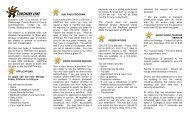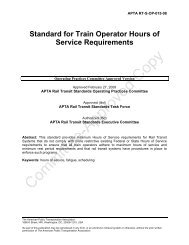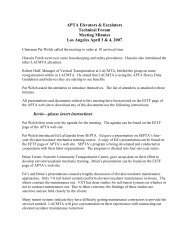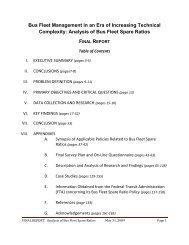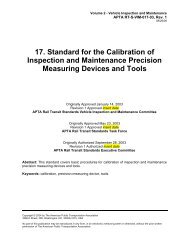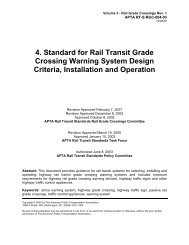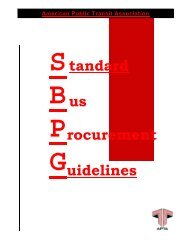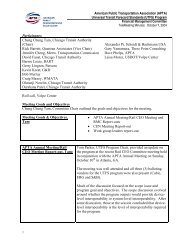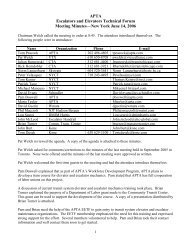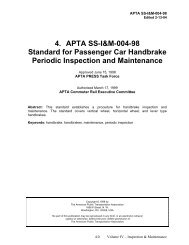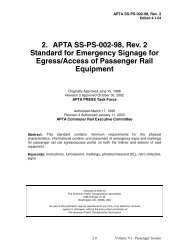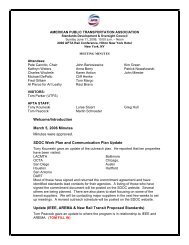Table of Contents - APTAStandards.com
Table of Contents - APTAStandards.com
Table of Contents - APTAStandards.com
You also want an ePaper? Increase the reach of your titles
YUMPU automatically turns print PDFs into web optimized ePapers that Google loves.
For example, the element could be further defined to represent some <strong>of</strong> the<br />
transit industry related services as follows:<br />
• CARDSRV= Card services (e.g. Autoload, Balance Protection)<br />
• CIDPRMT= Device Parameter Services (e.g. Display and Audio Configuration)<br />
• CIDAPPL = Transit Application Services (e.g. Business end-<strong>of</strong>-day)<br />
Each Service aggregate above needs to be further defined<br />
for structure and content for<br />
the<br />
sub-services available underneath them. Exhibit 4.3-8 below provides an example <strong>of</strong><br />
possible elements in the card services (CARDSRV) aggregate.<br />
Exhibit 4.3-8 CARDSV Aggregate Elements<br />
<br />
TYPE = “Threshold” THRESHVAL= “10.00” LOADAMNT=”20.0 0”<br />
<br />
<br />
<br />
4.3.6 Message Sequences<br />
OFX is a client-server system where an end-user uses a client application to<br />
<strong>com</strong>municate with a server at a financial institution. The form <strong>of</strong> <strong>com</strong>munication is<br />
requests<br />
from the client to the server and responses from the server back to the client.<br />
One or more requests can be batched in a single file.<br />
4.3.7 Security Requirements<br />
The main goals <strong>of</strong> OFX security are privacy, authentication and integrity. OFX utilizes<br />
encryption to maintain privacy, certificates to identify and authenticate servers, and a<br />
cryptographic hash to assist integrity verification. With OFX, security is applied at two<br />
different levels in the message exchange process, channel level and application level.<br />
The<br />
channel level security refers to the lower level security that is implemented in the<br />
<strong>com</strong>munication layer, whereas the application level security is independent <strong>of</strong> the<br />
underlying <strong>com</strong>munication protocol and aimed at protecting the data at the user level,<br />
just like password protecting word-processing documents. Exhibit 4.3-9 illustrates how<br />
these two level security schemes are applied.<br />
Page 38



